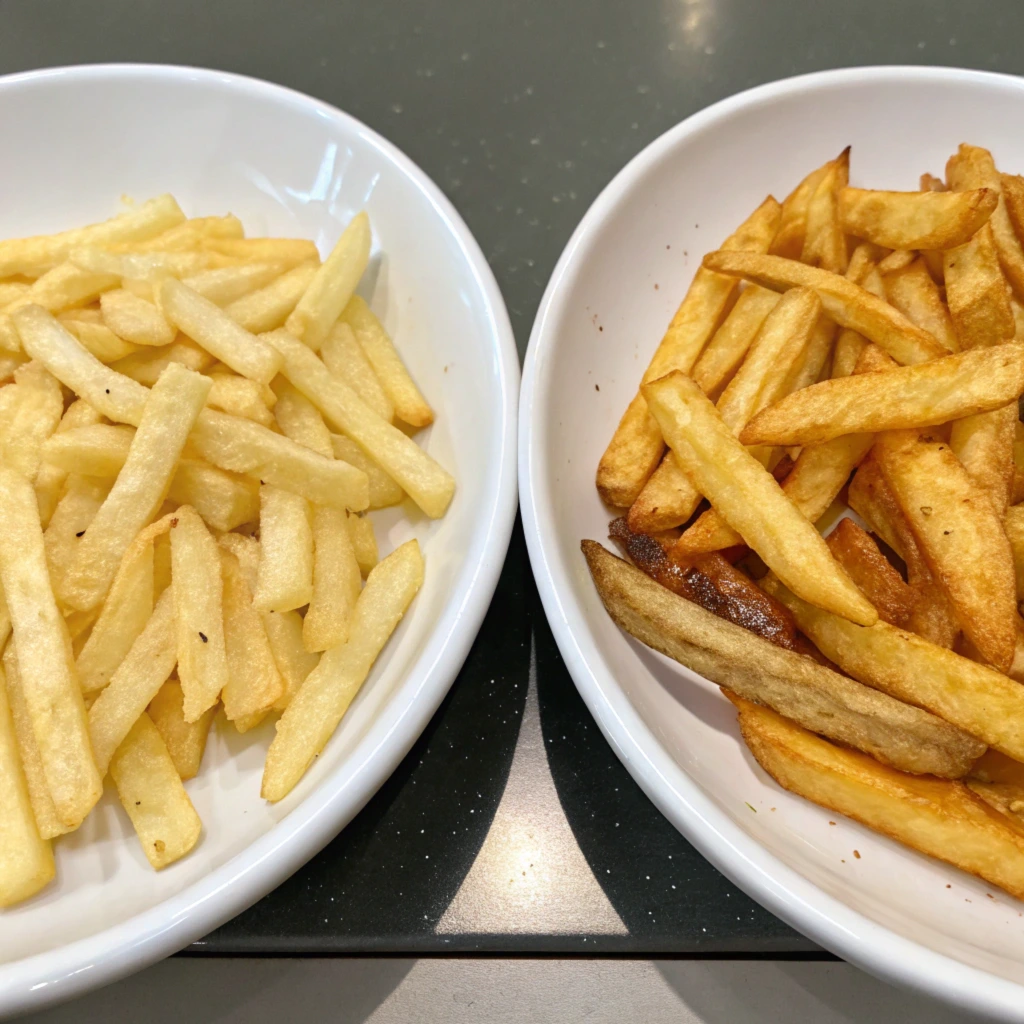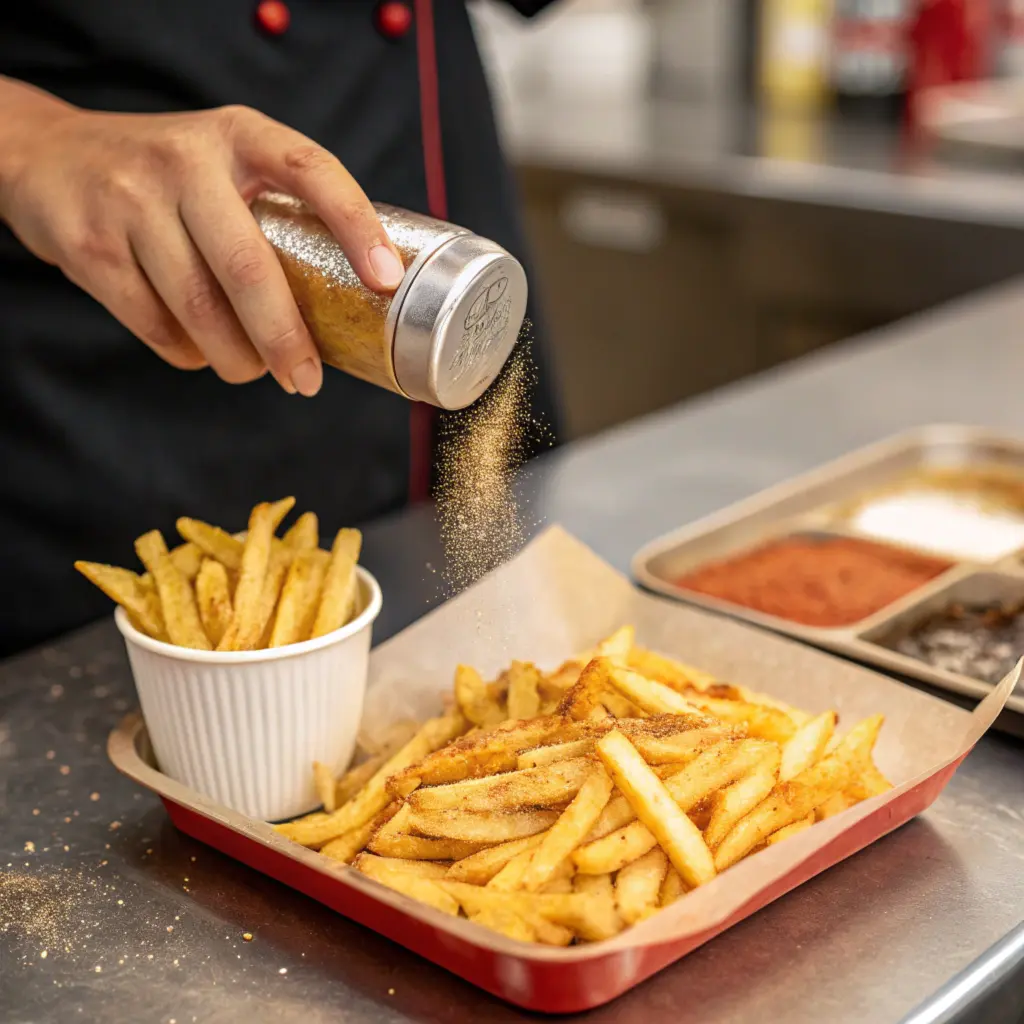When it comes to how to salvage old fries, many people are quick to toss them out, assuming there’s no way to restore their crispy goodness. But hold on those leftover fries have potential! This guide covers not only how to salvage old fries but also creative ways to transform them into delicious new dishes. From reheating methods that bring back their crunch to recipes that turn them into entirely new meals, you’ll discover every trick to breathe new life into your fries. Whether you’re dealing with fast-food leftovers or gourmet-style fries, you’ll find plenty of tips to avoid wasting food and enjoy every last bite.
Common Challenges with Reheating Fries

Why Do Leftover Fries Lose Their Texture?
Fries are delicate and lose their appeal quickly after cooling. The moment fries leave the fryer, their outer layer starts absorbing air, while the inner moisture migrates outward, softening the crispy exterior. This is why old fries often seem limp and greasy, even if they’re only a few hours old.
Different types of fries face unique reheating challenges. For instance, thin shoestring fries lose their crispness much faster than thicker steak fries due to their higher surface area. On the other hand, waffle fries or crinkle-cut fries might retain a bit more texture but still struggle to recover fully when reheated improperly. Seasoning can also play a role, coated or spiced fries sometimes reheat unevenly, leading to patchy texture or flavor loss.
Understanding the Science of Reheating: Oil, Starch, and Moisture
Understanding the balance of oil, starch, and moisture can help you tackle these challenges better. Fries are crisp because high heat locks in starch molecules while creating a hard outer shell. However, this effect reverses as the fries cool, with the shell becoming soft and moisture trapped inside escaping, leading to that disappointing sogginess.
Reheating in a microwave compounds the issue because the uneven heating rehydrates the fries’ surface, creating sogginess. To truly master how to salvage old fries, you need a method that removes excess moisture while crisping the exterior, such as using a hot oven or stovetop. It’s also worth noting that fries reheated multiple times are much harder to salvage due to further breakdown of their structure. Proper reheating techniques are essential when learning how to salvage old fries without degrading their texture further.
Best Methods for Reheating Old Fries
Using the Stove: Tips for Perfectly Crispy Fries
Reheating old fries on the stove is one of the best ways to revive their crispy texture. To get started, you’ll need a heavy skillet, like cast iron, to distribute heat evenly. Begin by preheating the skillet over medium heat. This step ensures the fries don’t absorb too much oil and remain crispy.
Next, add a small amount of oil or butter to the skillet, just enough to coat the bottom lightly. If you’re looking to keep it lighter, a cooking spray works too. Spread the fries out in a single layer, ensuring they aren’t crowded. Overcrowding traps steam, leaving fries soggy instead of crunchy.
Flip the fries occasionally as they heat up. This helps them cook evenly on all sides. Within 5 to 7 minutes, your fries should be golden and crispy, ready to enjoy. Add a sprinkle of salt, pepper, or your favorite seasoning for an extra burst of flavor.
Reheating Fries in the Oven
If the stovetop feels like too much hassle, the oven is your next best bet. Preheat the oven to about 400°F to 450°F, depending on your oven’s power. Place a baking sheet inside while it preheats to make sure it’s hot before adding the fries.
Line the fries on the hot sheet in a single layer, leaving space between them. This technique ensures the hot air circulates properly, making the fries crispy again. Bake for 7 to 10 minutes, checking frequently to prevent overcooking. Flip them midway through for even heating. By the time they’re done, your fries will taste almost as good as fresh!
Why You Should Avoid the Microwave
While the microwave might seem convenient, it’s not ideal for salvaging fries. Microwaves heat unevenly and tend to make fries limp and soggy due to rapid steam buildup. If you must use a microwave, pair it with a quick stovetop or oven session to bring back the crispness.
Creative Ways to Repurpose Old Fries

Turning Fries into New Dishes
When reheating gets old, why not transform your old fries into something entirely new? One fun option is to use a waffle maker to create crispy, golden waffle fries. Simply mash your fries slightly and spread them out in the waffle maker. After a few minutes, you’ll have a crunchy, unique snack that’s perfect for dipping in ketchup, ranch, or spicy aioli.
Another clever idea is to repurpose fries into hash browns. Chop them into small pieces, mix them with diced onions, bell peppers, or even shredded cheese, and season with salt and pepper. Fry the mixture in a pan until golden brown and crispy. These versatile hash browns are perfect for breakfast or as a side dish for burgers or sandwiches.
Incorporating Fries into Classic Recipes
Leftover fries also work wonderfully in classic recipes. One of the most popular options is poutine, a Canadian comfort food. Layer your fries with cheese curds and smother them in hot, savory gravy for a satisfying, indulgent meal.
For something more adventurous, try making French fry soup. Blend the fries into a creamy potato-based soup by adding milk, butter, spices, and even sautéed garlic or onions for extra depth. You can also top the soup with crumbled bacon or shredded cheese for added richness. These creative approaches allow you to enjoy your leftover fries in exciting and unexpected ways.
Tips for Storing Fries for Maximum Freshness
Optimal Storage Methods
When it comes to keeping old fries fresh for reheating later, proper storage is key. Start by transferring the fries into an airtight container. This prevents exposure to air, which can dry them out and degrade their texture. If possible, use a paper towel to absorb any excess grease before storing, as this keeps them from becoming overly soggy.
Additionally, always store fries in the refrigerator. Leaving them at room temperature for too long not only reduces their quality but can also make them unsafe to eat. For best results, refrigerate your fries within two hours of serving. Fries are best reheated within two days, so avoid letting them linger in your fridge for too long, as they may become stale or unappetizing.
How to Retain Crispiness for Future Use
To retain some of the fries’ original texture, consider lightly patting them dry before storage to remove surface moisture. If you’re saving restaurant fries, discard the paper bag they came in, as it traps steam, which softens the fries. Instead, transfer them to a sealed plastic or glass container.
For added crispiness during reheating, sprinkle a small amount of flour or cornstarch over the fries. This simple trick absorbs residual moisture and helps restore their crunch when reheating in the oven or on the stove. To prevent clumping, make sure the flour is evenly distributed. Proper storage and preparation ensure your fries are primed for a second serving that’s just as delicious as the first.
Special Considerations for Fast-Food Fries
Why Fast-Food Fries Are Harder to Salvage
Fast-food fries, like those from McDonald’s or Wendy’s, are particularly tricky to revive. These fries often contain preservatives or additives that alter their texture after cooling, making it harder to achieve the crispy, fresh-out-of-the-fryer feel. Additionally, the oil used by fast-food chains is typically less stable, breaking down more quickly during reheating. This can leave the fries with an unpleasant, greasy taste that’s hard to mask.
Moreover, fast-food fries are often thinner than restaurant or homemade fries. Their higher surface-area-to-volume ratio causes them to dry out faster, which is why they tend to taste stale or hard when reheated. Another factor is their salt content, which draws out moisture during storage, further affecting their texture.
Best Practices for Same-Day Reheating
If you’re working with fast-food fries, reheating them quickly is your best bet. Use a preheated cast iron skillet with a light coating of oil, flipping them frequently to ensure even crispness. Avoid overcrowding the pan, as this can trap steam and make the fries soggy. For added freshness, sprinkle some salt, garlic powder, or a pinch of paprika while reheating.
If time allows, consider repurposing fast-food fries instead of reheating them directly. For example, transform them into loaded fries by adding melted cheese, crispy bacon, and a drizzle of ranch dressing. Alternatively, mash the fries slightly and use them as a base for potato patties or croquettes. These creative methods not only mask reheating flaws but also turn leftover fast-food fries into entirely new and delicious dishes. By combining these tips, even fast-food fries can be salvaged with great results.

FAQs About Salvaging Old Fries
What Is the Best Way to Reheat Fries Without Them Getting Soggy?
Reheating old fries while keeping them crispy can be tricky, but the stovetop method is often the best. By spreading fries out in a single layer on a hot skillet with a small amount of oil, you allow them to crisp up evenly without trapping moisture. Alternatively, using a preheated oven helps achieve similar results. Avoid the microwave, as it tends to make fries soggy and unappetizing.
Can You Freeze Fries for Reheating Later?
Yes, you can freeze leftover fries for future use! Before freezing, make sure the fries are completely cooled and stored in an airtight container or freezer bag to prevent freezer burn. When reheating, go straight from the freezer to the oven or skillet, this helps maintain their texture and avoids extra sogginess.
Which Oils Are Best for Reheating Fries on the Stove?
High-smoke-point oils, like canola, sunflower, or vegetable oil, are ideal for reheating fries. These oils tolerate high heat without burning, ensuring your fries get crispy without an unpleasant, smoky flavor. For a richer taste, you can also use a mix of butter and oil.
How Long Can Leftover Fries Be Stored Before Reheating?
For the best results, store leftover fries in the refrigerator for no more than 1–2 days. Beyond this timeframe, the fries may lose their flavor and texture, making them harder to revive. Always use airtight containers to maintain freshness during storage.
Wrapping Up Your Fry-Saving Journey
The Value of Salvaging Old Fries
Learning how to salvage old fries not only saves food but also gives you a chance to get creative in the kitchen. Mastering how to salvage old fries opens up possibilities, from perfecting reheating techniques to transforming them into delicious dishes like hash browns or poutine. The options are far more versatile than you might think. By taking simple steps to store and reheat fries correctly, you can enjoy them just as much-if not more-the second time around.
Encouragement to Experiment and Avoid Waste
Don’t let those leftover fries sit forgotten! With a little effort and imagination, you can turn them into crispy, flavorful snacks or completely new dishes. Whether it’s on the stovetop, in the oven, or repurposed into recipes like hash browns, there’s always a way to give fries a second life. For more ideas, check out What Can Be Made From Leftover French Fries? for creative recipes and inspiration.
With these practical tips and tricks, you’re now fully equipped to handle any leftover fries like a seasoned chef. So, dig in and enjoy the crispy magic!

